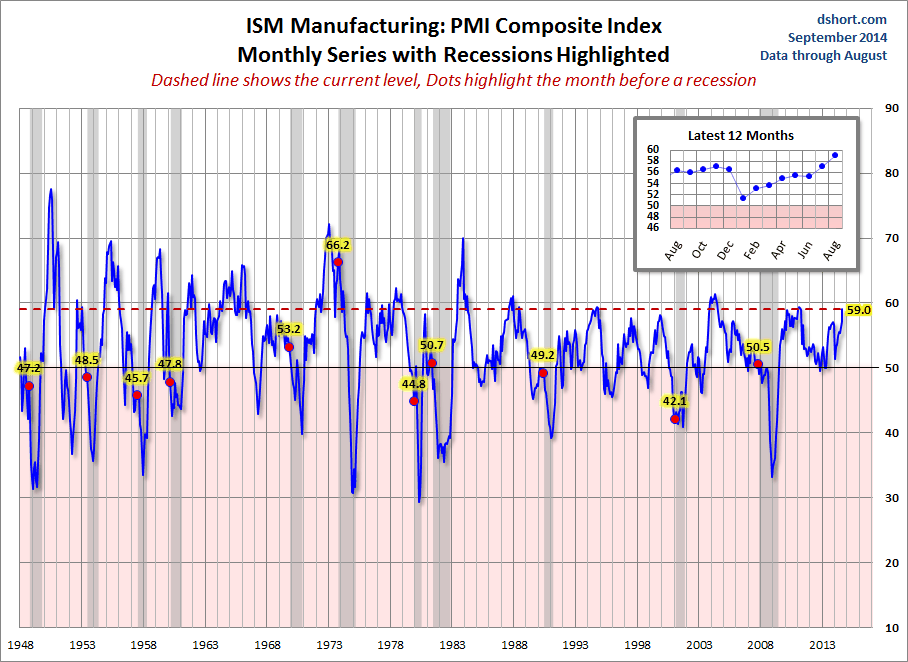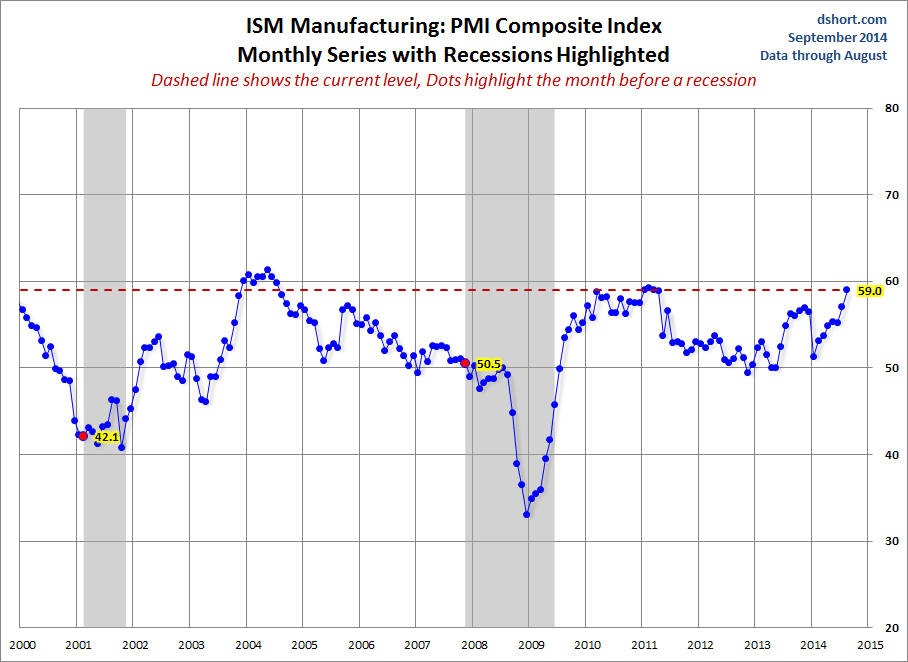Today the Institute for Supply Management published its monthly Manufacturing Report. The latest headline PMI at 59.0 came in above the July 57.1 percent, beating the Investing.com forecast of 56.8. The August level is the highest since March 2011.
Here is the key analysis from the report:
"The August PMI® registered 59 percent, an increase of 1.9 percentage points from July's reading of 57.1 percent, indicating continued expansion in manufacturing. This month's PMI® reflects the highest reading since March 2011 when the index registered 59.1 percent. The New Orders Index registered 66.7 percent, an increase of 3.3 percentage points from the 63.4 percent reading in July, indicating growth in new orders for the 15th consecutive month. The Production Index registered 64.5 percent, 3.3 percentage points above the July reading of 61.2 percent. The Employment Index grew for the 14th consecutive month, registering 58.1 percent, a slight decrease of 0.1 percentage point below the July reading of 58.2 percent. Inventories of raw materials registered 52 percent, an increase of 3.5 percentage points from the July reading of 48.5 percent, indicating growth in inventories following one month of contraction. The August PMI® is led by the highest recorded New Orders Index since April 2004 when it registered 67.1 percent. At the same time, comments from the panel reflect a positive outlook mixed with caution over global geopolitical unrest."
Here is the table of PMI components.

I'm reluctant to put too much focus on this index for various reasons, but they are essentially captured in Briefing.com's Big Picture comment on this economic indicator.
This [the ISM Manufacturing Index] is a highly overrated index. It is merely a survey of purchasing managers. It is a diffusion index, which means that it reflects the number of people saying conditions are better compared to the number saying conditions are worse. It does not weight for size of the firm, or for the degree of better/worse. It can therefore underestimate conditions if there is a great deal of strength in a few firms. The data have thus not been either a good forecasting tool or a good read on current conditions during this business cycle. It must be recognized that the index is not hard data of any kind, but simply a survey that provides broad indications of trends.
The chart below shows the Manufacturing Composite series, which stretches back to 1948. I've highlighted the eleven recessions during this time frame and highlighted the index value the month before the recession starts.

For a diffusion index, the latest reading of 59.0 indicates expansion. What sort of correlation does that have with the months before the start of recessions? Here are the eleven data points for the months before recessions arranged in numeric order. The latest data pointed (highlighted in red) is higher than the level prior to ten of the eleven.
42.1, 44.8, 45.7, 47.2, 47.8, 48.5, 49.2, 50.5, 50.7, 53.2, 59.0, 66.2
How revealing is today's 1.8 point change from last month? There are 800 monthly data points in this series. The absolute average month-to-month point change is 2.0 points. So the 1.9 point month-over-month change in today's headline PMI number is close to the average MoM change.
Here is a closer look at the series beginning at the turn of the century.

To reiterate the Briefing.com assessment: "The data have thus not been either a good forecasting tool or a good read on current conditions during this business cycle." The ISM reports nevertheless offer an interesting sidebar to the ongoing economic debate.
Note : I use the FRED USRECP series (Peak through the Period preceding the Trough) to highlight the recessions in the charts above. For example, the NBER dates the last cycle peak as December 2007, the trough as June 2009 and the duration as 18 months. The USRECP series thus flags December 2007 as the start of the recession and May 2009 as the last month of the recession, giving us the 18-month duration. The dot for the last recession in the charts above are thus for November 2007. The "Peak through the Period preceding the Trough" series is the one FRED uses in its monthly charts, as illustrated here.
